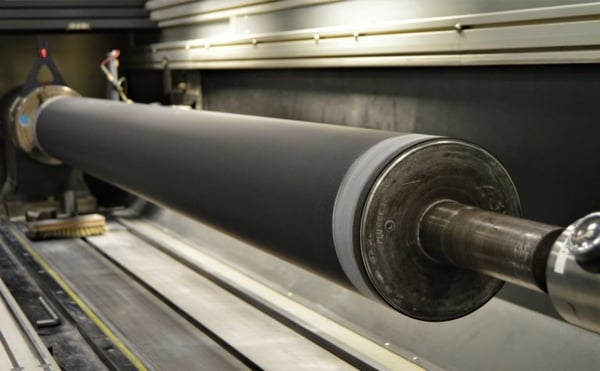Share this
Care and Maintenance of Flexo Print Sleeves, Cylinders, and Plates
by Luminite on Jan 14, 2022 8:00:00 AM

When it comes to maximizing the lifespan and usefulness of flexographic printing equipment, the importance of proper care and maintenance procedures cannot be overlooked.
Just as you would protect a new combine, dozer, or piece of manufacturing equipment; ensuring your flexo equipment is properly operated, handled, and stored reduces the risk of defect-filled prints.
Repeated use on the press, cleaning, and exposure to volatile chemicals will eventually weaken and damage your flexo printing sleeves - affecting the quality of your prints and therefore your company’s bottom line. Use these tips to keep your flexo equipment up and running for as long as possible.
Take Good Care of Your Flexo Print Sleeves and Plates: Flexo Print Maintenance
Elastomer flexographic printing sleeves are particularly efficient and durable against abrasion, aggressive inks, and solvents.
On the other hand, printing products manufactured from photopolymer, while valuable for certain types of jobs, are more vulnerable to:
- Swelling
- Wear
- Distortion
Whatever your choice, elastomer and photopolymer sleeves and plates are not invincible. They require some common-sense (and not so common-sense) care tactics while cleaning excess ink after one print job and stowing away for the next.
Here are some tips for the proper cleaning, maintenance, and storage of your flexo sleeves.
SPEED IS KEY
Although it might be tempting to take a break after a long printing session, waiting even a little while to begin cleaning can cause damage to your print sleeves and cylinders.
You must clean the sleeves and cylinders immediately after they’re removed from the press before the ink dries and hardens.
CHOOSE THE RIGHT CLEANING SOLUTION
Give your flexo sleeves and plates a good wash. Not so fast, though. It’s not a matter of just splashing on some ink-dissolving chemicals.
Different cleaning solutions work best with different types of inks. (And some don’t require volatile chemicals at all.)
Recommendations:
- Water-based inks
- Use mild soap and water
- Isopropyl or industrial alcohol works for most rubber types
- Rinse with water
- Solvent-based inks, oil-based inks, UV-based inks, and electron beam-based inks
- Use a solvent appropriate for your ink type or an approved nonvolatile wash-up solution
AVOID ABRASION
Remember: Your rubber print sleeves are durable, but they do have a soft surface. So, harsh cleaning tools and methods can scour away the rubbery surface of both elastomer and photopolymer print products. Avoid using rough materials, such as metal or wire, when cleaning your image carriers.
Recommendation: Use a soft-bristled brush to gently remove excess ink and debris. Natural-hair brushes work well and make it easy to clean gently and thoroughly.
AIR DRY
Let air work it’s evaporating magic. However, we don’t recommend using an air hose, as contaminants in the lines may attach themselves to your drying sleeves or plates.
The goal is to keep the surface clear of foreign debris that could negatively affect printing quality.
PROPER STORAGE
Wait at least 4 hours before storing cleaned sleeves and plates to ensure complete evaporation of solvents and other liquids. Wrap them in a black-backed paper or film which will block ozone and UV lights that could change their physical properties.
Storage temperature and conditions are critical:
- Never above 90˚ F
- Never below 32˚ F
- Little to no humidity
- Far from things that emit ozone, like electric motors and lights
Temperature is a big factor in plate/sleeve expansion and contraction. When the temperature rises, the polymers expand, and even the expansion of a thousandth of an inch can cause print registration issues. Same goes for contraction -- when sleeves get too cold, they contract, which can affect the quality of the print.
Store sleeves upright. Laying them on their side could damage the printing surface. Use a cushion if it must be placed horizontally.
Nickel/Nickelok sleeves should always be stored standing on a cushioned surface to protect the ends from damage.
Consequences of Improper Handling and Care:
While the rubber on most print cylinders is fairly durable, the cylinder itself can be damaged and become out of balance if they are dropped or hit excessively.
Operating a cylinder that has become out of balance can result in early gear wear, gear chatter, and bounce; increasing the likelihood of extended press downtime for maintenance. Once a cylinder has become out of balance, the process of rebalancing is complicated, and if the damage is severe, may require an entirely new cylinder and image carrier.
Handling your sleeves with care when loading/unloading, transporting or storing can save both time and investment.
Protect Your Investment by Properly Maintaining Flexo Sleeves
Failure to properly maintain your flexo print sleeves, plates, and cylinders results in preventable damage that’ll shorten their lifespan, force replacement, and result in defect-ridden prints. At the very least, inadequate cleaning and storage can leave debris that’ll diminish print quality.
But if you take proper precautions and employ the right products for the job, your flexo products will last and create quality prints every time.
Editor's note: This blog was originally published on November 22nd 2018, and was updated in February 2021.
Share this
- Flexographic Printing (81)
- Image Carrier (28)
- Elastomer sleeves (27)
- Ink Transfer (25)
- Quality (22)
- Flexo sleeve (20)
- News (18)
- printing defects (18)
- flexo printing defects (17)
- sustainability (13)
- Flexo Troubleshooting (12)
- Ink (12)
- Digital Printing (10)
- Flexo 101 (10)
- Flexo Inks, (9)
- Anilox (7)
- Blister Packaging (7)
- Cost (6)
- print misregistration (6)
- regulations (6)
- Corrugated Printing (4)
- pinholing (4)
- "Tradeshow (3)
- Digital Flexo (3)
- Gravure Printing (3)
- Insider (3)
- Load-N-Lok (3)
- Wide Web (3)
- direct laser engraving (3)
- flexo-equipment-accessories (3)
- gear marks (3)
- halo (3)
- testing (3)
- Narrow Web (2)
- bridging (2)
- feathering (2)
- filling in (2)
- mottled image (2)
- pressure (2)
- Labelexpo (1)
- dirty prints (1)
- doughnuts (1)
- embossing (1)
- kiss impression (1)
- October 2023 (2)
- September 2023 (1)
- August 2023 (1)
- July 2023 (3)
- June 2023 (1)
- May 2023 (5)
- April 2023 (1)
- March 2023 (2)
- February 2023 (1)
- January 2023 (3)
- December 2022 (1)
- October 2022 (3)
- September 2022 (2)
- August 2022 (2)
- July 2022 (3)
- May 2022 (1)
- April 2022 (4)
- March 2022 (2)
- February 2022 (5)
- January 2022 (7)
- December 2021 (1)
- November 2021 (3)
- October 2021 (2)
- September 2021 (1)
- August 2021 (1)
- July 2021 (3)
- June 2021 (1)
- May 2021 (4)
- April 2021 (4)
- March 2021 (4)
- February 2021 (2)
- December 2020 (1)
- November 2020 (1)
- October 2020 (2)
- September 2020 (1)
- August 2020 (3)
- July 2020 (2)
- June 2020 (3)
- May 2020 (1)
- April 2020 (1)
- November 2019 (3)
- October 2019 (1)
- August 2019 (1)
- July 2019 (1)
- April 2019 (1)
- March 2019 (1)
- January 2019 (1)
- October 2018 (2)
- August 2018 (1)
- July 2018 (1)
- June 2018 (1)
- February 2018 (2)
- October 2017 (1)
- September 2017 (2)
- January 2016 (1)
- February 2015 (1)
- January 2015 (1)
- December 2014 (2)
- September 2014 (1)
- February 2014 (1)
- January 2014 (1)
- December 2013 (3)
- October 2013 (1)
- September 2013 (1)
- June 2013 (1)
- January 2013 (1)


Comments (4)